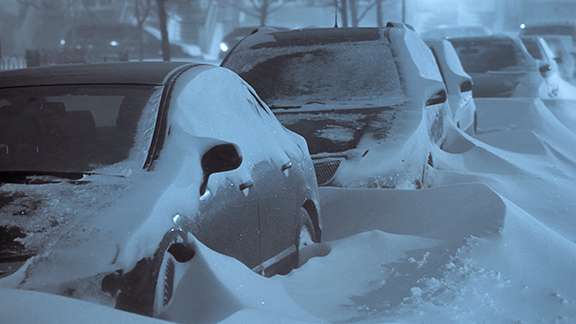Cold snaps linger despite climate change

Keep a winter coat and mittens handy. A new climate analysis from scientists at Pacific Northwest National Laboratory and the University of Reading (UK) found that under climate warming, cold air outbreaks, or CAOs, are projected to continue over North America but less frequently. In a geographic swath stretching from Alaska and southwestern Canada to the northwestern and mid-western United States, the top five coldest historical events may still happen. Indeed, as humans, ecosystems, and societal infrastructures adapt to an average warmer climate, these findings show continued future challenges in coping with extreme cold events.
"Our research isolated the changes of future cold air outbreaks to changes in the mean, the variance, and the skewness of daily surface air temperature" said Dr. Yang Gao, postdoctoral researcher and atmospheric scientist at PNNL. "Our analysis identified processes that will regulate future CAOs and climate factors that conspire to produce a distinct spatial pattern of CAO changes in North America."
Even as the climate warms, cold air outbreaks may continue to impact certain regions in Earth's mid-to-high latitudes and the Arctic.
"Understanding which atmospheric and surface processes modulate the CAO changes can provide valuable insights on how, in a changing climate, those processes interact to influence climate extremes," said Dr. Ruby Leung, PNNL Laboratory Fellow, atmospheric scientist and corresponding author on the study. "This will then help us improve climate models to more faithfully capture those processes and improve our predictions."
Cold air outbreaks may be more deadly than extreme heat spells. Certainly, they cause large economic losses through damages to crops, energy and other life-sustaining infrastructure. Looking at a large suite of climate simulations from multiple models allowed scientists in this study to identify common climate features that project cold air outbreaks in the future.
The PNNL-led research team analyzed model outputs from 26 global climate models used in the Intergovernmental Panel on Climate Change (IPCC) Fifth Assessment Report (AR5). Comparing the daily surface air temperature simulated for the present and future, they quantified the changes in CAO duration over North America. To determine what processes modulate CAO changes, they performed statistical analyses to isolate the contributions of changes from the mean, variance, and skewness of daily surface temperature to changes in CAO duration in the future. They compared the distinct spatial patterns of these changes to changes in large-scale circulation patterns such as atmospheric blocking and the equator-to-pole temperature gradients, as well as the spatial distribution of the 0oC isotherm, and sea ice and snow cover to identify factors that influence CAO events.
The team found that CAO changes in the future can be explained largely by the mean warming that reduced the chance of very cold temperatures. But, reduced variability of surface temperature due to amplified warming in the Arctic contributes as much as a 20% reduction of CAO from Alaska to the northeastern United States and eastern Canada. The changes of CAOs are also affected by changes in the skewness of surface air temperature, which are modulated by the frequency of atmospheric blocking and the melting of snow cover and sea ice as the climate warms.
These findings provide important insights on processes that influence cold extremes, with implications for human health, agriculture, energy, and other sectors of the society to climate extremes in the future.
The team will analyze a multi-model ensemble of global climate simulations to examine changes in extreme events such as heat waves and drought. Further, they will analyze their potential linkages with atmospheric blocking and other atmospheric circulation features and surface conditions, as the same features could have very different effects on climate extremes on the other end of the extreme spectrum.
More information: "Persistent Cold Air Outbreaks over North America in a Warming Climate." Environmental Research Letters 10(044001). DOI: 10.1088/1748-9326/10/4/044001
Journal information: Environmental Research Letters
Provided by Pacific Northwest National Laboratory














.jpg)



